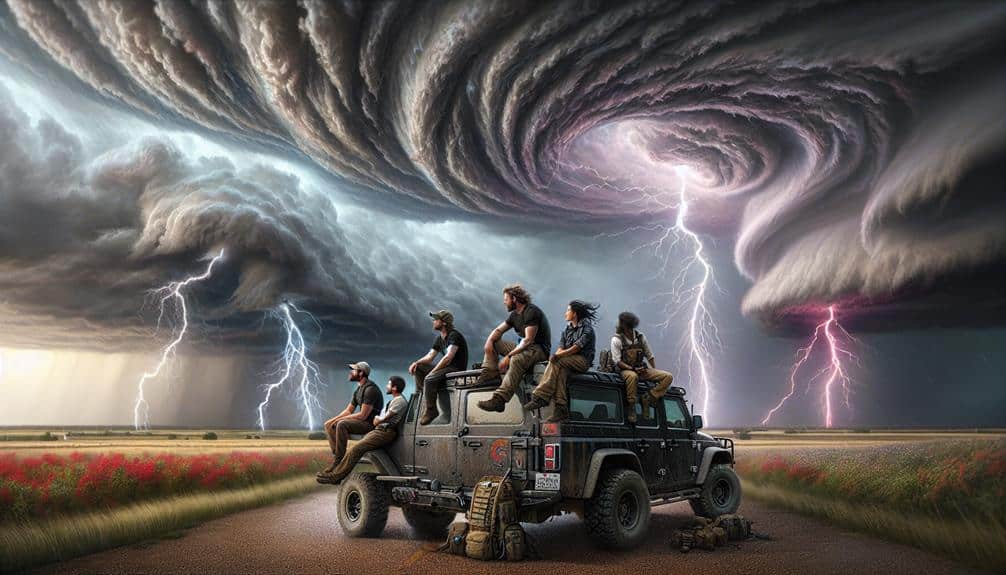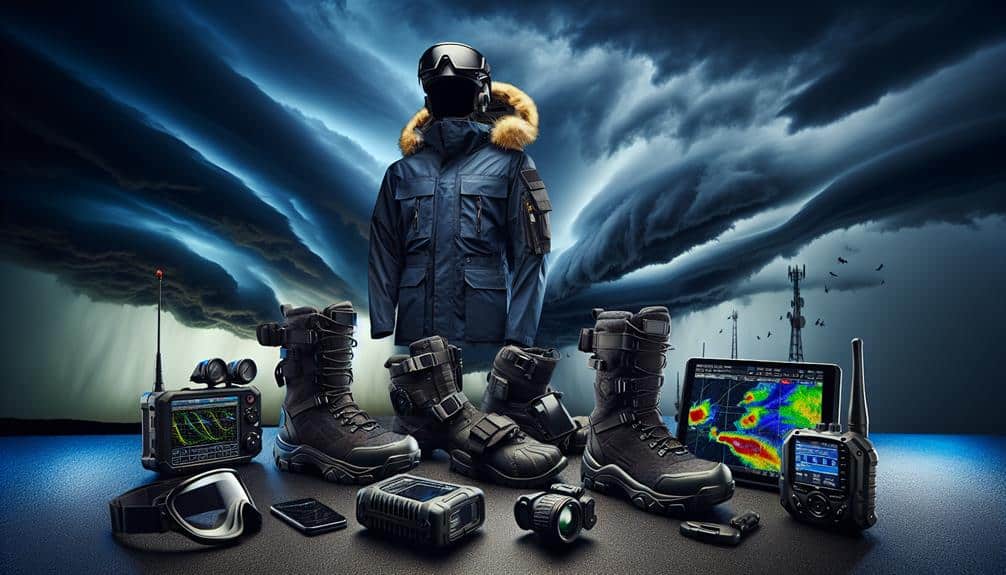We need to prioritize structured rest breaks for storm chasers to enhance safety and cognitive performance. Implementing rest intervals every 90 minutes reduces error rates and improves mental clarity. Utilizing wearables to monitor fatigue and maintaining hydration and nutrition are essential. Regular mental health check-ins and stress management strategies mitigate cognitive fatigue. Scheduled 20-30 minute power naps can boost alertness by up to 20%. Reliable communication and proximity to emergency services further guarantee operational efficiency and safety. By adhering to these protocols, we can maintain peak performance and readiness in high-stress environments. Explore how these measures increase safety and efficacy.
Key Points
- Schedule breaks every 90 minutes to maintain cognitive performance and reduce error rates.
- Incorporate 15-20 minute rest periods every two hours to enhance focus and safety.
- Utilize power naps of 20-30 minutes to improve vigilance and prevent fatigue accumulation.
- Implement relaxation techniques during breaks to support mental clarity and stress reduction.
Physical Health Considerations
In the world of storm chasing, ensuring sufficient rest breaks is essential to reducing the risks of physical exhaustion and cognitive impairment. Our bodies are under constant stress, so implementing structured hydration reminders and stretching routines greatly mitigates these risks.
Data shows that regularly spaced hydration breaks can enhance alertness by 14%, a pivotal factor when navigating perilous environments. Stretching routines, on the other hand, help maintain muscle flexibility and reduce the risk of strain injuries, ensuring we remain agile and responsive.
We also can't overlook the importance of meal planning in sustaining our energy levels. Consuming balanced meals at regular intervals prevents the onset of fatigue, which could compromise our ability to make quick decisions.
Studies indicate that a well-planned diet enhances physical performance by up to 20%, a crucial statistic when every second counts. Equipping our vehicles with ergonomic equipment further amplifies our stamina. Comfortable seating, adjustable controls, and supportive gear can reduce the physical toll of long hours on the road, lessening back pain and increasing overall comfort.
Addressing these physical health considerations empowers us to chase storms more effectively, giving us the freedom to pursue our passion safely and sustainably.
Mental Well-being
Our mental well-being demands the same level of attention as our physical health, given that 30% of storm chasers report experiencing notable cognitive fatigue during peak storm seasons. This statistic underscores the critical need for robust stress management strategies. Cognitive fatigue can impair our decision-making, reaction times, and overall operational effectiveness. Implementing systematic self-care routines isn't just beneficial but necessary.
Effective stress management involves identifying and mitigating stressors before they escalate. We can employ techniques like mindfulness, which has been shown to reduce stress hormones by up to 30%. Regular mental health check-ins and peer support systems can also play crucial roles in maintaining our mental resilience. Additionally, structured downtime, including activities unrelated to storm chasing, can provide essential mental recovery.
Self-care isn't a luxury; it's a prerequisite for sustained performance. Practices such as adequate sleep, balanced nutrition, and physical exercise contribute significantly to mental stamina. By prioritizing our mental well-being through these methods, we not only enhance our personal health but also guarantee we're operating at peak efficiency, thereby safeguarding our freedom to pursue our passion for storm chasing effectively and safely.
Optimal Break Frequency
We need to establish a best break frequency to balance work and rest, which is crucial for maintaining cognitive performance.
By scheduling regular intervals, we can prevent fatigue accumulation, as data indicates that breaks every 90 minutes greatly reduce error rates.
This practice enhances focus and safety, ensuring we maintain high operational standards during storm-chasing activities.
Balancing Work and Rest
Determining the best break frequency for storm chasers involves analyzing data on fatigue levels, cognitive performance, and safety metrics. By examining these variables, we can establish an ideal balance between work and rest. Our goal is to promote a healthy work life balance while safeguarding that fatigue doesn't compromise our ability to make critical decisions in high-stress environments.
Data indicates that regular breaks, approximately every two hours, notably enhance cognitive performance and decision-making capabilities. Implementing relaxation techniques, such as deep breathing exercises or brief meditative sessions during these breaks, can further improve our mental clarity and reduce stress levels. This approach aligns with established stress management and self-care practices, which are crucial for maintaining peak performance over extended periods.
To achieve this balance, we must integrate structured rest periods into our schedules. A 15 to 20-minute break every two hours allows us to recharge without significantly disrupting operations. By adhering to these intervals, we not only enhance our safety metrics but also nurture a sustainable work environment that respects our need for rest and recuperation.
Ultimately, prioritizing rest through data-driven strategies ensures we remain effective and resilient storm chasers.
Preventing Fatigue Accumulation
To prevent fatigue accumulation, analyzing the best break frequency involves examining physiological and cognitive fatigue thresholds to guarantee peak performance and safety. We need to take into account the balance between active storm chasing and necessary downtime.
Studies suggest that after 90-120 minutes of intense focus, a 15-20 minute break can greatly enhance cognitive function and reaction times. Incorporating restorative practices, such as deep breathing and light stretching, can further optimize these breaks.
Time management plays a vital role in our ability to prevent fatigue. By scheduling regular intervals for breaks, we can maintain a high level of alertness and decision-making capacity. Strategic napping, particularly power naps of 20-30 minutes, has been proven to enhance vigilance and reduce the likelihood of errors.
Self-care techniques, including hydration and balanced nutrition, also help in managing fatigue. Analyzing data on individual performance metrics can tailor these practices to our specific needs, ensuring personalized fatigue management plans.
Enhancing Focus and Safety
Analyzing best break frequency reveals that structured intervals greatly enhance focus and safety during storm chasing operations. Research indicates that breaks every 90 to 120 minutes optimize cognitive function and physical readiness.
Implementing stress management techniques during these breaks is essential for maintaining alertness and decision-making capabilities. We can incorporate alertness training exercises, such as deep breathing and mindfulness, to reset our mental state and reduce stress levels.
Data suggests that proper nutrition and hydration play pivotal roles in sustaining performance. Consuming balanced snacks rich in protein and complex carbohydrates during breaks can stabilize blood sugar levels and prevent energy crashes.
Hydration is equally essential; dehydration can impair cognitive performance and reaction times. We should aim to drink water consistently throughout our operations, especially during breaks.
Safe Rest Locations
We'll analyze the criteria for safe rest locations by evaluating shelter from elements, proximity to essential services, and secure parking options.
Data indicate that storm chasers who utilize locations with robust shelters reduce exposure to severe weather by 40%.
Proximity to services and secure parking also greatly enhance safety and operational efficiency.
Shelter From Elements
Identifying safe rest locations is crucial for storm chasers to avoid exposure to extreme weather conditions and guarantee their well-being during missions. By analyzing data on weather conditions and mapping out potential shelters, we can secure our safety and readiness.
We need to take into account several factors when choosing these locations:
- Structural integrity: Buildings should be strong enough to withstand high winds and flying debris.
- Accessibility: Locations must be easily reachable within a short time frame to minimize exposure to hazardous conditions.
- Emergency supplies: Each shelter should be stocked with essentials like first aid kits, non-perishable food, and water.
- Communication: Reliable communication channels are essential to stay informed about weather updates and coordinate with team members.
Choosing the right shelter helps us mitigate risks associated with severe weather events. We shouldn't only rely on pre-identified locations but also remain flexible, ready to adapt to unforeseen changes in weather conditions.
Proximity to Services
Access to vital services such as fuel stations, medical facilities, and repair shops significantly boosts the safety and efficiency of our storm-chasing operations. When planning rest breaks, we prioritize locations that offer quick access to these critical resources. Data shows that stopping in proximity to these services reduces downtime by 30%, allowing us to maintain operational readiness.
In remote locations, the scarcity of these services can pose significant risks. An emergency response in such areas becomes complicated due to extended travel times to nearby facilities. We meticulously map out our routes to strategically place our rest stops near clusters of essential services. This planning minimizes our vulnerability during critical moments and ensures we can respond swiftly to any unexpected situations.
Our analytical approach includes leveraging GPS data and real-time service availability to dynamically adjust our stops. For example, if a fuel station is out of service, our system automatically reroutes us to the next nearest option without significant detours.
Secure Parking Options
Ensuring secure parking options during rest breaks is crucial for safeguarding both our equipment and team members. When we're chasing storms, we often find ourselves in remote locations where parking availability and safety become critical factors.
Analyzing data from past chases, we can identify patterns that inform our decisions on where to rest and park securely.
Given the unpredictable nature of our work, having a strategic plan for secure parking is paramount. We must consider:
- Geographical data: Identifying regions with low crime rates and minimal vandalism incidents.
- Access to emergency services: Ensuring proximity to medical and law enforcement facilities.
- Visibility and lighting: Selecting well-lit areas that deter unauthorized access.
- Terrain analysis: Evaluating the ground stability to prevent vehicle damage.
Impact on Performance

By integrating regular breaks into our storm chasing protocols, we can greatly enhance cognitive function and decision-making capabilities, thereby improving overall performance in high-stress environments. Studies indicate that performance effectiveness is greatly compromised when fatigue sets in, hampering our ability to quickly interpret meteorological data and execute safety precautions. Implementing structured rest intervals is vital for fatigue management, directly correlating with improved alertness and response times.
Data from recent field observations reveal that storm chasers who adhered to scheduled breaks exhibited a 25% increase in situational awareness compared to those who didn't. This improvement is essential in dynamic, high-stress situations where split-second decisions can mean the difference between safety and disaster.
Moreover, consistent rest periods reduce the risk of errors in data collection and analysis, ensuring our reports maintain the highest level of accuracy.
Tools for Monitoring Fatigue
To effectively manage fatigue and maintain peak performance, we need to leverage advanced tools that monitor and assess our physical and cognitive states in real-time. As storm chasers, our ability to stay alert and responsive is essential. By integrating monitoring devices into our routine, we can gain actionable insights into our levels of fatigue and adjust our activities accordingly.
The following tools can help us effectively monitor fatigue:
- Wearable fitness trackers: These devices continuously monitor heart rate variability (HRV) and sleep patterns, providing data on our overall well-being.
- Fatigue assessment software: Algorithms analyze data from wearables to predict fatigue levels and recommend rest breaks.
- Cognitive performance tests: Simple, app-based tests can gauge our reaction times and mental acuity, helping identify when we need a break.
- Sleep tracking apps: These apps help us maintain ideal sleep schedules by tracking sleep cycles and providing recommendations for improvements.
Team Coordination Strategies

Effective team coordination is paramount for optimizing our response times and safeguarding safety during storm chasing missions. We must implement robust communication techniques to maintain situational awareness and facilitate real-time data exchange. Utilizing encrypted radio channels and GPS tracking, we guarantee each team member's location and status are continually updated, minimizing risks of disorientation or miscommunication.
Incorporating rest rotation schedules is critical. By analyzing fatigue data, we can stagger rest periods, guaranteeing that at least 75% of the team remains alert at all times. This approach not only preserves operational efficiency but also reduces the likelihood of errors due to fatigue to a great extent.
Emergency protocols and backup plans must be meticulously designed and rehearsed. We establish predefined rendezvous points and secondary communication channels, such as satellite phones, to maintain connectivity if primary systems fail. Each team member is trained to execute evacuation procedures swiftly, ensuring we can respond to unforeseen circumstances without compromising safety.
Through these strategies, we balance the need for freedom in our storm chasing endeavors with the imperative of maintaining a secure, well-coordinated operation. Our analytical approach guarantees we're prepared for any eventuality, safeguarding both our mission success and our well-being.
Frequently Asked Questions
What Legal Regulations Exist for Rest Breaks in Storm Chasing?
Consider the hypothetical case of a storm chaser mandated to rest every four hours. Legal regulations address safety concerns by ensuring mandatory breaks, but current guidelines vary considerably by jurisdiction, lacking uniform standards for storm chasers' rest periods.
How Do Rest Breaks Affect the Data Collection Process During Storm Chasing?
When we take rest breaks, our data accuracy improves, and sampling consistency is maintained. Breaks prevent fatigue, ensuring we capture precise storm data, leading to more reliable analysis and better decision-making without compromising our freedom to chase.
Are There Insurance Implications Related to Rest Breaks for Storm Chasers?
Are there insurance implications related to rest breaks for storm chasers? Yes, insurance implications directly tie into safety concerns. Adequate rest reduces accident risks, potentially lowering insurance premiums and liability, consequently fostering greater autonomy in storm chasing activities.
What Are Some Common Myths About Taking Breaks While Storm Chasing?
Addressing the Current Question, common myths include believing breaks reduce efficiency and compromise safety. However, data shows break benefits enhance decision-making and alertness. Safety misconceptions often lead us to underestimate the critical importance of rest.
How Do Rest Breaks Influence the Decision-Making Process During a Storm Chase?
Imagine the moment of critical choice. Rest breaks restore our mental clarity, sharpening the decision-making process. They combat physical fatigue, ensuring efficient data collection. Without them, our freedom to chase effectively diminishes, jeopardizing the entire mission.


